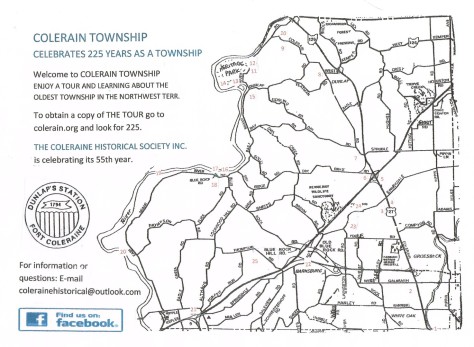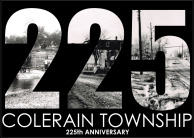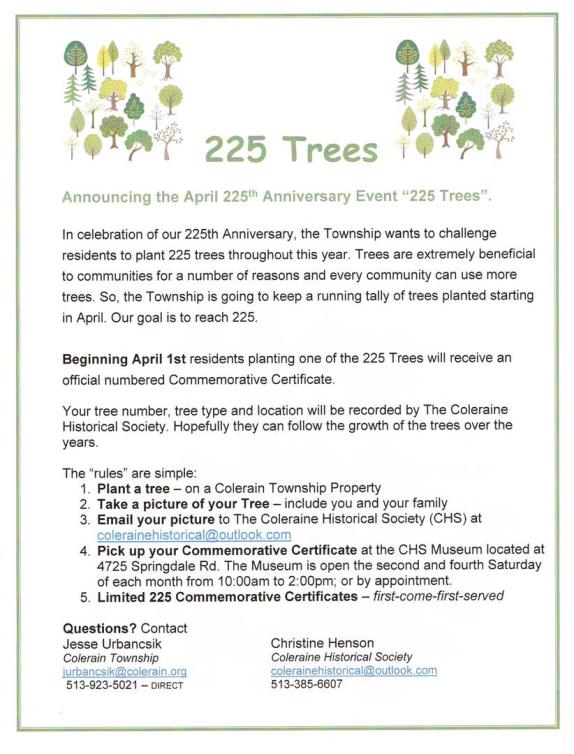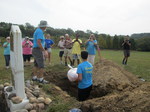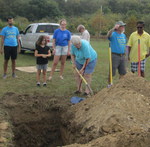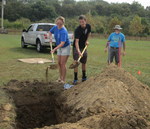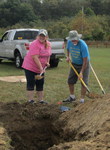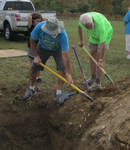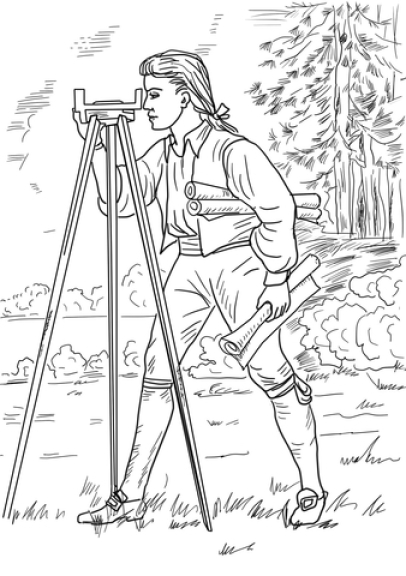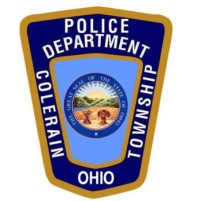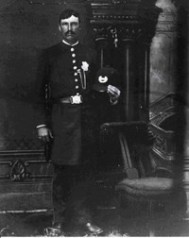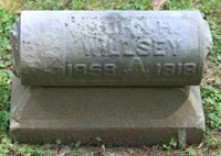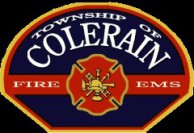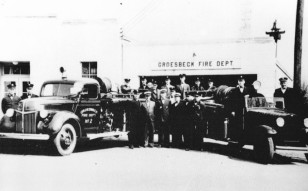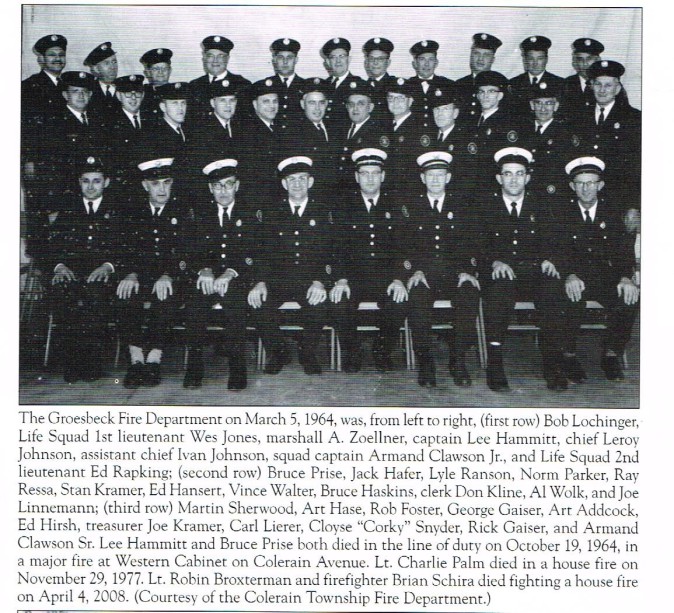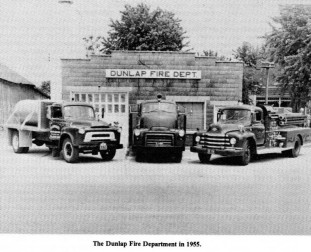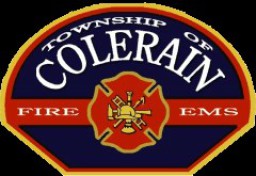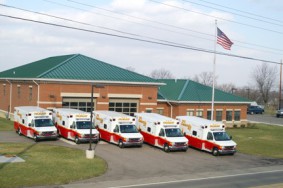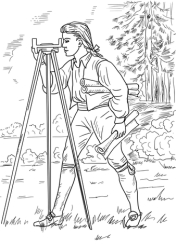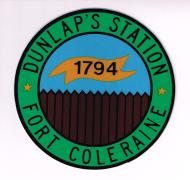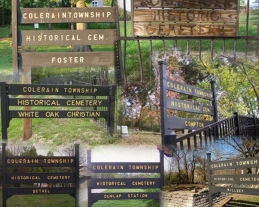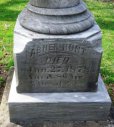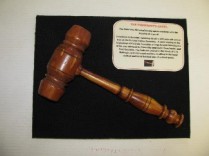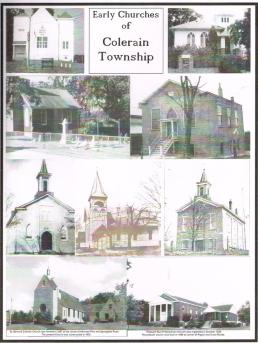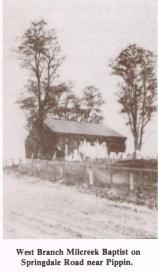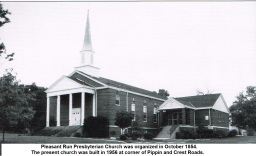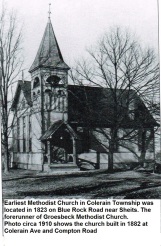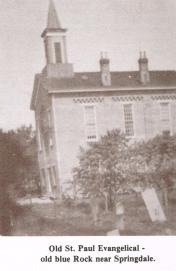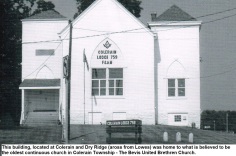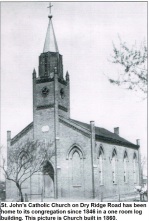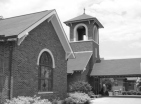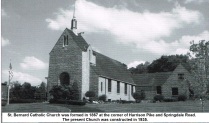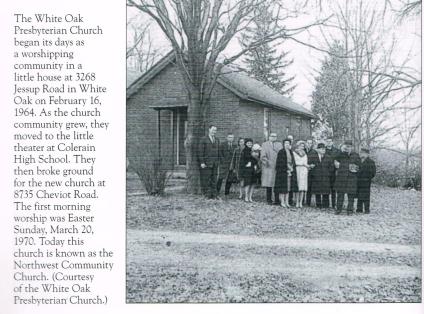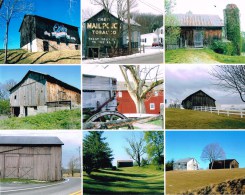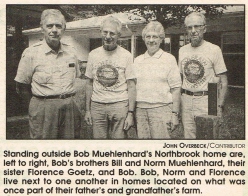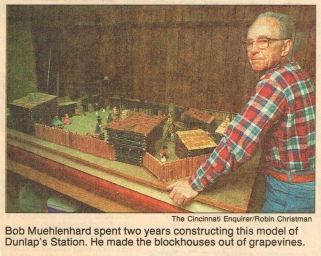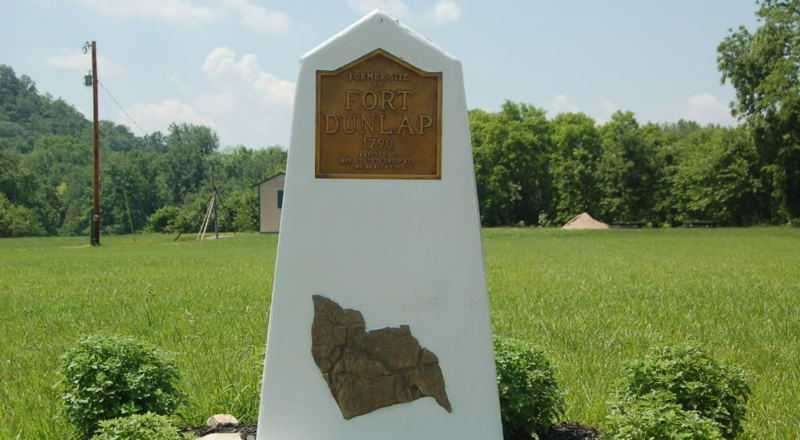
225th Anniversary
Did you plant a Tree in 2019???
Certificates are still available for:
225 TREES
In celebration of our 225th Anniversary,
ColerainTownship challenged residents
to plant 225 trees throughout 2019.
Residents who planted one or more trees in 2019, will receive an official numbered Commemorative Certificate. Your tree number, tree type and location will be recorded
by The Coleraine Historical Society. Hopefully they can follow the growth of the trees over the years.
The “rules” are simple:
1. Plant a tree/trees – on a Colerain Township Property
2. Take a picture of your Tree/trees – try to include you and your family
3. Email your picture to The Coleraine Historical Society (CHS) at colerainehistorical@outlook.com
4. Pick up your Commemorative Certificate at the CHS Museum located at 4725 Springdale Rd. The Museum is open the second and fourth Saturday of each month from 10:00am to 2:00pm; or by appointment.
5. Limited 225 Commemorative Certificates – first-come-first-served
Questions?
Christine Henson at colerainehistorical@outlook.com 513-385-6607
Quasquibicentennial
225 Years of Colerain History
It has been 225 years since Colerain Township was founded in 1794.
Here in the Township, we have a rich history with great community members. We are truly excited to spread the word of our anniversary this year!
Throughout this year we will have our normal events and actives, but this year we will host a few extra events/items to make this year one to remember.
The Township will be partnering with the Coleraine Historical Society and Northwest Local School Board to make this year special.
The Historical Society will be publishing historic articles every month that will appear on CERKL and FACEBOOK. The Township will also be featuring a “Rotating Rotunda Series” which displays these articles and pictures outside the Trustee’s Chambers every month.
Help us celebrate this landmark year in Colerain Township!
************
225 TREES Certificates are still available.
225th Time Capsule
BURIED - September 28, 2019 OPEN - October 1, 2044
LOCATION Heritage Park
Click on any photo to start slideshow
Project timeline is
May 15 to August 31, 2019.
Flat John Dunlap Project
5 pictures will be randomly selected from entries and
the 5 children will:
- Receive a Restaurant Gift Cards
- Be introduced at the September Board of Trustees Meeting
- Have their picture buried in the 225th Anniversary Time Capsule
Open to any students who attends any elementary School in Colerain Township
For details and picture, see May 6, 2019 article below
*************
Below are the articles CHS has provided to CERKL.
They are published on 1st and 15th of each month.
Thanks to CHS members Chris Henson, Margie Mohr
and Colerain Historian Larry Shad for their research.
*************
CERKL Published August 15, 2019 1 of 2
THE COLERAIN TOWNSHIP
POLICE DEPARTMENT
Original research and article by Frank Scholle
Additional information provided by Christine Henson,
The Coleraine Historical Society
From the beginning of time, civilization has sought order, safety, and security. Down through the centuries, this has always been true.
We lock the doors and windows of our home, we lock our cars, and provide safe keeping for other valuables. We feel safer knowing that we have taken precautions to protect the people and things important to us.
Early on people relied primarily on themselves and those close to them. But as the population increased, people needed assistance in the area of protection. Perhaps we sought out those who were bigger and stronger than us. Those who could step in when help was needed.
Down through the years, the enforcing of law and order and protecting life and property has taken various forms. When we are in need of a police person; we look to those in our community who have the jurisdiction to take care of matters that are beyond our control.
In Colerain Township, we are fortunate to have Police Protection at the highest level; 24 hours a day – 7 days a week.
The Colerain Township Police Department evolved as did the Township.
*********************************
From Colonial times into the 1800s, the enforcement of laws was handled by a Constabulary. Webster’s dictionary defines a Constabulary as “the organized body of Constables and watchmen of a particular district or county”.
Protecting a community relied on a “watch system” which was composed of community volunteers whose primary duty was to warn the public of impending danger. The night watch was not a particularly effective crime control tool, as watchmen often slept or drank on duty. A system of Constables augmented the watch system.
Constables were appointed or elected at the local level for specific terms. They were not paid and many did not wear a uniform. Constables were considered official law enforcement officers, usually paid by the fee system for warrants they served. In addition to supervising night and day watchmen, Constables had a variety of non-law enforcement functions to perform as well, including serving as land surveyors and verifying the accuracy of weights and measures. It wasn’t until the 1830s when the idea of a municipal police department emerged in the United States. There are still communities in the United States and even Ohio that still appoint Constables.
NOTE: read more about Colerain Constable John H. Willsey in another article
*************************************
In 1910, the largest Township in Ohio, Colerain Township, was sparsely populated with about 4,000 people. It was primarily a farming community. By 1950, the population had doubled to almost 8,000 people. But after WWII, the number of people living in the Township, exploded to almost 30,000 by 1960.
In the 1950s, Colerain Township’s law enforcement was still being handled by a Constabulary. CHARLIE LOSACKER is said to have been a part-time Constable in 1951. A future Police Chief of Colerain Township, BILL TERRELL, who was Charlie Losacker’s son-in-law, joined him as a Constable in 1957 at the princely sum of $1.00 an hour when on duty.
When a major problem arose, or the Constables were off duty; police from neighboring jurisdictions and the Sheriff’s office helped to cover the Township.
One major problem was the jurisdiction of a Constable was limited. They could not write any tickets on State highways such as Colerain Ave. They were only permitted to write tickets on County roads for DUIs and vehicular homicides!
As the Township grew, the need for definitive jurisdiction became more and more apparent. CARL KESSEN, who was a part-time policeman in North College Hill, joined Losacker and Terrell in patrolling Colerain Township. DON FINLEY was next to join.
In 1970, BILL TERRELL went to the Township Trustees and asked for a defined police jurisdiction. It was granted. BILL TERRELL became the first Police Chief of Colerain Township. In 1977, when Bill retired, the Colerain Township Police Department had 15 officers (8 full time and 7 part time).
BUTCH FREY was Acting Police Chief for 9 months after Bill Terrell retired. Frey was the first full-time Police Officer hired by Colerain.
The Township then hired ROGER JOHANNES as Police Chief. While Johannes was Chief, the Department had some CETA people as Officers; but when the federal money ran out, the burden of funding was on the Township. The Township had limited funds and could not afford to keep all of the officers, so some were dismissed.
NOTE: The Comprehensive Employment and Training Act - CETA was a United States federal law enacted by the Congress, and signed into law by President Richard Nixon December 28, 1973 to train workers and provide them with jobs in the public service. The program offered work to those with low incomes. Full-time jobs were provided for a period of 12 to 24 months. The intent was to impart a marketable skill that would allow participants to move to an unsubsidized job. It was an extension of the Works Progress Administration (WPA) program from the 1930s. In 1982, CETA was replaced by the Job Training Partnership Act
In January 1986, by vote of the Township Trustees, the Colerain Police Department was disbanded.
It did not take long, after disbanding the Police Department, for problems to arise. A combined resident-government-sheriff’s office review committee was formed. This committee concluded that Colerain Township was just too large to rely on the Hamilton County Sheriff’s Department and neighboring communities for law enforcement. The Trustees voted to put a Police Levy on the ballot for Colerain residents to decide. Voters passed the first Police levy in November 1986. And in January 1987, ED PHILLIPS was hired as Police Chief. What a difference a year makes!
ED PHILLIPS “succeeded” Roger Johannes as Chief and served from 1987 to 2001. Phillips was charged with rebuilding the Police Department.
STEVE SARVER was selected as Police Chief from a pool of 20 candidates. He was with the Cincinnati Police Department for 25 years, and served as Chief of the Amelia Police Department for 1 year. Sarver served from 2001 to 2007.
DAN MELOY was promoted to Police Chief in January 2008. Dan was a graduate of Colerain High School, was a paratrooper in the U.S. Army, then rose through the ranks in the Colerain Police Department to become its Chief. Meloy then served as Township Administrator.
MARK DENNEY is the current Colerain Police Chief. Mark was raised in Colerain and graduated from Colerain High School. After serving as a Cheviot Police Officer, like Chief Meloy, Mark Denney also rose through the ranks to become Chief in January 2014.
**************************
Down through the years there have been tremendous changes.
LOCATION - For many years, the Police Department was located in a back office at 4725 Springdale Road – present home of Police Impound Lot and Coleraine Historical Society. They had one small room in the back garage before expanding to the second floor. Expansion continued and the Police Department moved into a small one room office trailer with a “holding cell” made of fencing. Next came a larger 2 room trailer before moving to shared quarters with the Dunlap Fire House at Kemper and Old Colerain. What a palace the “new” Administration Building must have felt like when they moved into the east wing in 1994.
COMMUNICATION – Communications began with the Township Police having their own low band radio in their patrol cars. This band also tied the Police, Fire and Maintenance Departments together so they could talk to each other. Inside the Police offices, you could not communicate with the dispatcher from just anywhere; you had to move around to make contact.
Next came portable radios. Still on a low band system with short antennas, which really did not work well. Communications improved with the change to high band radios with 8 channels.
When computers were put in the Police Station and patrol cars, it was no longer necessary to go through a dispatcher for everything. Now from patrol cars, officers can receive run information and check license plates.
UNIFORMS – In the beginning, Township Trustees provided the police uniforms: 2 summer and 2 winter; but the care and maintenance was up to the individual officer. The State and County told the Township the makeup and colors of the uniform. Bullet proof vests were introduced in the 1970s. They were heavy and uncomfortable to wear. Today they are lighter in weight and provide greater protection. In early 2019, the Trustees authorized purchase of new bullet proof vests.
WEAPONS - The Township issued officers a .38 caliber hand gun; but most officers bought and carried their own weapon - a .38 or .357. Officers today carry 9MM handguns. Officers must be bonded to carry a firearm; but the Township covers the special liability insurance.
PATROL CARS – In the early days, officers painted their own police cars. The cars were white with a blue top, to distinguish them from the Sheriff’s cars. The Township residents want a car they can recognize.
PERSONNEL – The department currently employs 56 Officers and 12 Support Staff.
AWARDS – Awarded every 3 years, the Colerain Police Department has received the CALEA Accreditation 5 times – 2005, 2008, 2011, 2014, and 2017; the “With Excellence” designation was awarded the last 3 times.
The Commission on Accreditation for Law Enforcement Agencies, Inc. (CALEA) is a credentialing authority (accreditation), based in the United States, whose primary mission is to accredit public safety agencies, namely law enforcement agencies, training academies, communications centers, and campus public safety agencies.
Since the first CALEA Accreditation Award was granted in 1984, the program has become the primary method for an agency to voluntarily demonstrate their commitment to excellence in law enforcement. This is a rigorous, voluntary process that less than 10% of the 18,000 law enforcement agencies in the United States undergo.
CERKL Published August 15, 2019 2 of 2
Constable John H. Willsey | Colerain Township
https://police-museum.org/line-of-duty/20th/constable-john-h-willsey-colerain-township/
Age: 58
John Willsey, a fur buyer, worked part time as a constable, transporting prisoners to the Hamilton County jail. On these occasions, he would hire a partner to accompany him on the trips. Often, his partner of choice was Orville (or Isaac) Ogg. During August 1918, on one of these trips, Constable Willsey discussed with Ogg the fact that he had recently sold his home and that the proceeds from that sale were inside his house.
On August 15, 1918, Ogg entered Constable Willsey’s home and hid behind a door. When Constable Willsey walked in, Ogg shot him in the back of the head, killing him.
Constable Willsey was survived by three children, Rachael A. (31), Lida M. (29), and Raymond (15). He was buried in the Willsey Cemetery on Eagle Creek Road in Colerain Township.
Constable John H. Willsey’s grave site in Willsey Cemetery
Ogg was arrested and charged. During his trial, he threatened the lives of the Willsey family. Ogg was found guilty of second degree murder and sentenced to prison. Twenty-six years later, during 1944, Ogg escaped from prison and, while the Willsey family lived in fear for many years, he was never heard from again.
During 2008, Colerain Township Police Sergeant Angela Meyer submitted sufficient proof to the Ohio and national memorials to have Constable Willsey recognized. His granddaughter, Mary Jane Sefton, aged 82, of Guilford, Indiana, attended his induction ceremony at the national memorial.
If you have information, artifacts, archives, or images regarding this officer or incident, please contact the Greater Cincinnati Police Museum at memorial@police-museum.org.
CERKL Published July 22, 2019 1 of 4
Colerain Fire Department
A history by The Coleraine Historical Society
The time is 1931. The place is Groesbeck, OH in rural Colerain Township. Times are rough. Citizens are concerned as the country is in a depression. A group of citizens gather at Ed Honnert’s garage on Colerain near Galbraith. They call themselves, “the Groesbeck Improvement Association” (G.I.A.). A big concern is fire protection.
In 1933, G.I.A. purchased a used 1930 Model A Ford Pumper. John Schulte was appointed first Fire Chief. The first fire occurred on December 25, 1933 – a barn on the Rocker property (now Burgundy Court and Rocker Drive).
In 1975, the Groesbeck and Dunlap Fire Departments merged into the Colerain Township Fire Department. The Colerain Township Fire Department began with 8 full-time firefighters, including Chief Cloyce “Corky” Snyder (1975 – 1988), and approximately 60 volunteer firefighters.
Under Chief Bruce Smith (1988 – 2015), the Fire Department would expand to 5 fire stations, increase personnel from 75 to 150 and in 1989 add Paramedics to the EMS division.
The Colerain Township Department of Fire and Emergency Medical Services of today extends way beyond just protecting the community from fire hazards. By comparison, in 1965 the department responded to 365 EMS runs. In 2018, they responded to 10,250 calls with 80% EMS runs.
Under only it’s third Fire Chief, Chief Frank Cook (2015 to present), the 160 personnel of the Fire Department respond to all hazards and provide emergency response to all fires, medical calls, rescues, hazardous materials incidents, and other miscellaneous emergencies and service requests.
Read more detailed History in 3 more articles on founding of Groesbeck Fire Department, Dunlap Fire Department, and merging the 2 to become Colerain Township Fire Department
CERKL Published July 22, 2019
2 of 4
Groesbeck Fire Department
Reprinted with permission of The Coleraine Historical Society; from book “Colerain Township – Revisited” by Ruth J. Wells, first CHS President
The time is 1931. The place is Groesbeck, OH in rural Colerain Township. Times are rough. Citizens are concerned as the country is in a depression. A group of citizens gather at Ed Honnert’s garage on Colerain near Galbraith. They call themselves, “the Groesbeck Improvement Association”. A big concern is fire protection. The North College Hill Fire Department will be unable to answer calls in Colerain Township.
The Groesbeck Improvement Association (G.I.A.) elects the following officers: Ed Honnert, President; Carl Huber, Vice President; Mrs. Frank Gellhaus, Recording Secretary; Robert Ahrens, Corresponding Secretary; George K. Foster, Treasurer. Ed Honnert appointed George K. Foster the Chairman of the Fire Committee. The first G.I.A. Carnival was held the summer of 1933; in reality, a celebration dedicating Van Zant Road (which is now Galbraith Road). In 1933, G.I.A. purchased a used 1930 Model A Ford Pumper. John Schulte was appointed Fire Chief. The first fire occurred on December 25, 1933 – a barn on the Rocker property (now Burgundy Court and Rocker Drive).
In 1934, the G.I.A. called a meeting, at which it was decided to let the Fire Department re-organize and elect their own officers. It was held at Fieler’s Garage, where the first engine was housed. The first meeting of the Groesbeck Fire Department was held on March 6, 1934. The following officers were elected: Fred Finke, Senior Chief; John Herrmann, Asst. Chief; Ivan Johnson, Marshall; Elbert (Bud) Aston, Captain. The first fire bell was donated by the North College Hill Fire Department. This bell is now at the Galbraith Road Station as part of a memorial to firefighters killed in the line of duty.
In October 1934, a dance was given at Bevis Garage, where a ton of coal was raffled off as a door prize to make extra money. Also in 1934, Colerain Township agreed by contract to pay $35.00 for each Fire Department run.
In 1937, the new Community Hall and Fire Station was built. In 1939, the Ladies Auxiliary was organized and a Bell Telephone System was installed in the fireman’s homes. In 1940, a new Ford Howe Pumper Truck was delivered.
Cloyce “Corky” Snyder joined the Fire Department in 1948 and served for 40 years. He was Volunteer Chief from 1958 to 1961. He returned to that post in 1967. He then later became the first paid Fire Chief.
In 1954, the Township Trustees – William “Bud” Thomas, John Herrmann, and Dale Diefenbacher – decided to organize a Fire Department in the Dunlap area. In 1955, 2-way radios were installed in the fire pumpers. In 1957, a jeep was bought and the first grass fire fighting rig was built. Also, it was decided to start a Life Squad. New men were trained and a 1958 Cadillac Ambulance was purchased.
A new fire house was built by the G.I.A. on Galbraith Road to have more room for apparatus. In September 1959, the first meeting was held there. In 1960, Plectrons in Home Radios to call firemen were purchased. In 1962, a new Howe 1000 GPM Custom Pumper was ordered. Al Zoellner became Fire Chief.
On October 19, 1964, the worst fire in the history of Groesbeck occurred in the Western Cabinet Company at Colerain and Jonrose. Roy Johnson was Chief. The fire started in a paint booth because of a defective exhaust system. Pumpers worked 8 hours and 9 hose lines were hooked up to 2 hydrants. The call came in at 6:05pm and the men returned to the station at 2:15am. 30 men responded…only 28 returned. Captain Lee Hammitt and Fireman Bruce Price died in the fire. They were the first Colerain Firefighters to die in the Line of Duty.
In 1965, the Groesbeck Fire Protective Association, Inc. was chartered by the State of Ohio. Robert Foster was its first President. Voters passed a one mill Fire Levy. Also the first 4 paid firemen were hired: Charles Frankel, Bill Clark, Dick Baker and Clyde Kohne.
In 1967, the Groesbeck Fire Department divorced itself from the Groesbeck Improvement Association. They moved into a new fire station at 3360 West Galbraith Rd. A new 1967 Howe Custom Pumper truck was delivered.
In 1970, Corky Snyder, Chief of Groesbeck and Bud Williams, Chief of Dunlap started talks about a Colerain Township Fire Department. In 1975, the 2 departments formally merged.
GROESBECK FIRE CHIEFS
John Schulte – 1933 Cloyce Snyder – 1958 to 1961
Fred Finke, Sr. – 1934 to 1953 Al Zoellner – 1962
Al Forman – 1953 to 1956 Roy Johnson – 1963 to 1965
Al Zoellner – 1957 Ivan Johnson – 1966
Cloyce Snyder – 1967 to 1975**
Cloyce “Cork” Snyder – (**after combining with Groesbeck) Colerain Chief 1975-1988
CHARTER MEMBERS OF GROESBECK FIRE DEPARTMENT
Frank Drake Louis Kramer Elbert Aston
John Herrmann Christ Ruehl John Frey
Ed Bokelman Carl Thole Henry Fieler
John O’Shea Fred Finke, Sr. Robert Foster
Joe Kramer Harold Harris Carlton Huber
Ivan Johnson Ralph Lockwood Ed Lockwood
Frank O’Neal Robert Gauggel August Wagner
CERKL Published July 22, 2019
3 of 4
Dunlap Fire Department
Reprinted with permission of The Coleraine Historical Society; from book “Colerain Township – Revisited” by Ruth J. Wells, first CHS President
In 1954, Colerain Township Trustees began making plans to form a fire department for the northern half of the township. Prior to this the northern area was covered by the Groesbeck Department assisted by neighboring departments – Fairfield, Ross and New Baltimore.
On October 18, 1954 the first officers were appointed. The Trustees appointed the officers for the first year; thereafter to be elected. Dick Bowman was chosen Chief; Gene Taylor, Asst. Chief; Ray Walters as Marshall; and George Matt to serve as Captain. Availability of fire equipment was discussed – Trustees saying that bids would have to be advertised for several weeks; and, after bids, it would take 90 days for the truck to be equipped. A committee was chosen to mail cards to the residence owners in the territory for the purpose of locating water supplies such as cisterns, wells, creeks, lakes, etc.
George Matt’s old garage sign was repainted to read Dunlap Fire Department. A committee was chosen to draw up a constitution and by-laws. The department was established with the Township purchasing and owning the equipment and the membership owning the station. With this in mind, it was necessary to hold fund raising events to buy the “extra” items needed to maintain the Fire Department.
Approximately 100 people attended the first 2 meetings where it was decided how to raise money for the department. The first fund raiser was a raffling off of a rooster netting about $450. Future fund raising events would include the carnival and yearly turkey raffle. The Ladies Auxiliary was formed to help raise money for the department. They worked tirelessly to provide extra equipment and furnishings for the firehouse. They went to fire scenes, in many cases, to provide water and refreshments for the working firemen.
The site chosen for the Dunlap Fire Department was at the corner of Kemper Road and Colerain. In February 1955, the department membership was set at 40 with 10 substitute firemen. In March a tower to mount a siren and hang hose was planned. A block tower was erected at a cost of $250. Also the Township purchased a John Bean pumper.
The first 2 fire calls were received on July 17th. They were received at the station. There were 4 phones located in neighboring residences and a fifth located at the fire house. When an operator received a call for the Fire Department, all 5 phones would ring – “we guarantee an answer because someone will be at one of these residences at all times”. When it was clear as to the location of the fire, the siren woul by activated by the one receiving the call merely by pressing a button next to the phone. When a minimum of 2 firemen were available, a pumper would leave for the scene of the fire. Any additional firemen who came to the firehouse, looked at the call board and responded to the fire in their personal vehicles.
The Call Board was located in the alarm room. Next to it was a filing bin which held cards with the addresses of all residents in the area. Every piece of propertyin the area was registered with the department. On the registration cards was information such as: the main power switch to the house, water supplies, and other information that might help or hinder the department while fighting a fire. On this card was also a map of the shortest route to the property. The cards were filed by property numbers. Smaller bins were also located by the call board and were placed alphabetically by property owner names. This system was used to check and double-check so mistakes were not made in response.
Upon arrival of the new pumper, drivers were assigned and crews were made up for each driver. Dates were set up for each driver to take his crew on practice runs. These crews were set up regarding day or night availability.
In January of 1956, it was announced that the Trustees had located and purchased a 1953 GMC cab-over, engine cab and chassis. From then until completion, the members hand built the compartments, tank, and apparatus onto the truck making it the first Dunlap water tanker. This was a 1200 gallon capacity tank.
Later in 1956, the members of the department took the Ohio State Department of Education training program, completing it in October. At this time the Dunlap Fire Department received its Class “A” rating. This was a first for a rural Fire Department in Hamilton County; as at the time there were only 10 Class A fire departments in the State of Ohio. This was quite an accomplishment given the short time the Fire Department had been in existence.
Each unpaid volunteer was supplied with a metal fire helmet, a rubber rain coat, and a pair of rubber boots for personal protection in fighting fires. In 1957, a two-way radio was acquired to make response to a call in the shortest time possible. In the following years, the Plectron notification devices were provided to all active members. This notification system was changed to calls to Hamilton County dispatcher and replaced the previously described phone system.
In 1962, the original one bay station was enlarged, additional space was built for a meeting room, kitchen and indoor plumbing. In 1963, a Peter Pirsch pumper on an International chassis was ordered and 2 more equipment bays were added to the east end of the firehouse.
In 1968, it was decided that Life Squad services should be provided by the Fire Department. Training was provided for interested personnel. Prior to this time, all Life Squad services were provided by the Young Funeral Home in Ross and Mt. Healthy. In 1969, a Plymouth station wagon was received, which served as a Life Squad unit. It was replaced in 1970 with a Braun unit on an International chassis.
In the early 1970’s two additional drive-through bays were added to the north side of the station. A Ford FTI pumper was purchased. The original bay was converted into a meeting room. The 1962 addition was converted into offices.
The Dunlap Department and the services continued to grow as the Township expanded in population. In 1974, meetings were held with the Groesbeck Fire Department and in January 1975 a merger between the two volunteer Fire Departments was made forming the current Colerain Township Fire Department.
DUNLAP FIRE CHIEFS
Dick Bowman – 1954 to 1955
Gene Taylor - 1955 to 1960
Emerson “Bud” Williams - 1960 to 1975
Cloyce Snyder – (after combining with Groesbeck) Colerain Chief 1975 to 1988
CERKL Published July 22, 2019 4 of 4
Colerain Fire Department
A history by The Coleraine Historical Society
The time is 1931. The place is Groesbeck, OH in rural Colerain Township. Times are rough. Citizens are concerned as the country is in a depression. A group of citizens gather at Ed Honnert’s garage on Colerain near Galbraith. They call themselves, “the Groesbeck Improvement Association” (G.I.A.). A big concern is fire protection.
In 1933, G.I.A. purchased a used 1930 Model A Ford Pumper. John Schulte was appointed first Fire Chief. The first fire occurred on December 25, 1933 – a barn on the Rocker property (now Burgundy Court and Rocker Drive).
Cloyce “Corky” Snyder joined the Fire Department in 1948 and served for 40 years. He was the first paid Fire Chief. Station 26 in Groesbeck bears his name.
In 1954, the Township Trustees – William “Bud” Thomas, John Herrmann, and Dale Diefenbacher – decided to organize a Fire Department in the Dunlap area.
On October 19, 1964, worst fire in Groesbeck history occurred at the Western Cabinet Company on Colerain Ave at Jonrose. 30 men responded…only 28 returned … Capt. Lee Hammitt and Firefighter Bruce Price both died in that fire. They were the first Colerain firefighters to die in the Line of Duty.
In 1975, the Groesbeck and Dunlap Fire Departments merged into the Colerain Township Fire Department. First Fire Chief of the new department was Cloyce “Corky” Snyder. The Colerain Township Fire Department began with 8 full-time firefighters including Chief Snyder, and approximately 60 volunteer firefighters.
Tragically on November 29, 1977, Colerain Township lost another Firefighter when Lt. Charles Palm died in a house fire. Palm Park on Springdale bears his name.
Township growth continued into the 1980’s. And it became increasingly difficult to retain volunteer firefighters and Emergency Medical Technician (EMT)’s. In 1984, Colerain’s volunteer system was disbanded and stations were staffed 24 hours a day with paid personnel.
From a membership of approximately 75 in 1986, the department grew to over 100 by 1989. In May of 1989, paramedics were added to the department’s EMS division.
In October of 2004 a 5th fire station opened at the corner of Kemper Road and Pippin Road – Station 109 Pleasant Run. In 2015, this station was dedicated to retiring Chief G. Bruce Smith
April 4, 2008 Colerain experienced the loss of two firefighters in the Department’s first line of duty deaths in over thirty-years - when Captain Robin Broxterman and Firefighter Brian Schira died fighting a house fire.
In 2015, Chief Bruce Smith retired having served the department for over 40 years and Chief Frank W. Cook assumed the duties as the Chief of the Department.
Colerain Township Department of
Fire and Emergency Medical Services
Excerpts reprinted with permission from 2018 Colerain Fire & EMS Annual Report
In 2019, under only it’s third Fire Chief Frank Cook, Colerain Township Fire & EMS is comprised of 160 personnel.
It is an Insurance Services Offices (ISO) Class One fire department. There are over 30,000 fire departments across the United States. Only 225 have achieved an ISO Class One rating.
The Fire Department operates from 5 fire stations with a $13.8 million operating budget while providing various disciplines of labor including: fire protection, emergency medical services, hazardous materials response, enhanced 911 communication; community risk reduction; fire investigations; and technical rescue operations.
In 2018, Colerain Township Department of Fire and EMS was recognized as Ohio’s EMS Agency of the Year by the Ohio Department of Public Safety’s Division of EMS for its commitment and innovative efforts in improving the quality of life in the community through fall prevention and QRT risk reduction.
Colerain Township was first to develop the Quick Response Team or QRT. A cooperation of the Colerain Township Department of Fire & EMS, the Colerain Township Police and the Addiction Services Council – the “Team” consists of a firefighter/paramedic paired with a police officer and member of the council, who work as a team to offer drug intervention and assist with admission to rehabilitation and recovery facilities.
Chief Cook’s vision is to keep the department progressive and attuned to new techniques that provide enhanced safety to both our firefighter/paramedics and the citizens of Colerain Township.
NOTE: No articles were submitted in June. The July 1 article was the Flood Pole Dedication information
CERKL Published May 6, 2019
Flat John Dunlap Project
Who is John Dunlap?
John Dunlap was a surveyor from Coleraine, Ireland. In 1790 he surveyed the land at the bend in the Great Miami River. He staked out 106 acres and oversaw the construction of the fortified settlement called Dunlap’s Station. In 1794 when Colerain became a Township, John Dunlap served as the first Clerk.
Flat John Dunlap Project
To celebrate Colerain Township’s 225th Anniversary, The Coleraine Historical Society is teaming with Elementary Schools in the Township for the “Flat John Dunlap Project”. Much like the well-known “Flat Stanley”; we are curious to see where John Dunlap will travel this Summer.
Students who attend any elementary School in Colerain Township are encouraged to color the picture and take Flat John Dunlap with you on your Summer Adventures. Participants are asked to take pictures of themselves with their Flat John Dunlap and email them to The Coleraine Historical Society at colerainehistorical@outlook.com
Be sure to include Name, Age, School, Grade and phone Number
Pictures received will be displayed on Coleraine Historical Society website,
at the 4th of July Celebration and at Heritage Day of September 28, 2019.
Project timeline is May 15 to August 31, 2019.
5 pictures will be randomly selected from entries and the 5 children will:
- Receive a Restaurant Gift Cards
- Be introduced at the September Board of Trustees Meeting
- Have their picture buried in the 225th Anniversary Time Capsule
Questions? Contact
Jesse Urbancsik Christine Henson
Colerain Township Coleraine Historical Society
jurbancsik@colerain.org colerainehistorical@outlook.com
513-923-5021 – DIRECT 513-385-6607
CERKL Published May 6, 2019
Who was John Dunlap?
The Dunlap family has a large well documented genealogical history. But there seems to be little known about John Dunlap, the surveyor, land speculator and founder of Dunlap’s Station.
The Northwest Territory had been established in 1787, within which Judge Symmes had organized the Miami Company and then advertised the availability of this land.
John Dunlap was one of John Symmes’ confidential surveyors as early as 1788. He commanded two companies of surveyors that made the first exploration of the area in September 1788. They mapped out Columbia, the first Symmes Purchase settlement. In 1789, Dunlap surveyed land in what became Hamilton County Ohio.
In 1790, he made his way up the valley of the Great Miami River to the notable bend in the river. The river here bends to the west then curves back to the east, forming a “U” shaped tract of floodplain that the early settlers would have coveted as farmland.
Here, John Dunlap mapped out 106 acres which he named after his birthplace of Coleraine, Ireland. (It is located next to the 2,000-year-old Colerain Earthwork and one or more sacred Adena Indian Mounds).
By April 30, 1790, Dunlap had staked out Dunlap’s Station/Fort Coleraine and construction of the fortified settlement was begun. It was to be the first inland settlement. It consisted simply of little cabins clustered together upon a space of about an acre, built to face each other and, their roofs so placed as to slope outward and so low that it is said the dogs would jump from the stumps to the top of them, and so get into the enclosure. There was constructed a stockade of rather weak pickets, made of small timber or logs split in half and thrust into the ground, which stood only about eight feet high. Small block-houses were built at the corners of the square formed by the stockade. About thirty persons, men, women, and children lived; including only eight or ten capable of bearing arms.
As the year continued, Indians were seen gathering in the nearby countryside. The settlers made an application (as it was called) to Fort Washington (Cincinnati) for protection. Lieutenant Kingsbury was sent with thirteen soldiers to strengthen and protect the Station.
Only one year after it had been settled, Dunlap' station was the scene of the fiercest and longest sustained Indian attack recorded in the annals of Hamilton county. For several days in early January, 1791, Indians who had been gathering in the vicinity in considerable force attacked the Fort. On the eighth they made the fatal attack. The whole strength of the garrison was eighteen soldiers and eight or ten of the settlers capable of bearing arms. The entire number in the Station, including women and children, not counting the soldiers, did not exceed thirty souls. The Indians were estimated at from three to five hundred, led by the infamous renegade, Simon GIRTY.
Dunlap’s Station was destroyed by the Indians during the attack on the fort in 1791. It was never rebuilt and no one is sure of its exact location. What does exist is the Historic Dunlap Station Cemetery presumed to have been near the early settlement.
A few remaining settlers held onto the surrounding lands until 1794; when it was learned that the lands linked to the settlement lay outside the boundaries of the patent granted to John Cleves Symmes. It seems that John Dunlap was inclined to land speculation, surveying a town site and selling lots, to which he did not have title. There were years of appeals and congressional actions which required they purchase their land a second time. The pioneers gradually abandoned their homes over the years and in time, the walls and cabins rotted away and the land returned to its earlier primitive condition as Dunlap’s Station/Fort Coleraine passed into history and ceased to exist.
In Ford’s History of Hamilton County 1881, Ford lists among the first township officers in 1794 as “John Dunlap, Clerk”.
CERKL Published April 15, 2019
Historic Cemeteries
of Colerain Township
Reprinted from
“Colerain Township Revisited” by Ruth J. Wells;
first President of Coleraine Historical Society
There are about 30 old church and family cemeteries whose care depends on Colerain Township. They have been cared for and 11 (most accessible) now have wooden signs naming them. They are important in preserving early Colerain Township History.
1. DUNLAP STATION CEMETERY, located on East Miami River Road (near Heritage Park), is probably the oldest in the area. It is assumed that the earliest burials took place beginning about 1791 of settlers living in the little Fort who either died there or were killed by Indians. There are no gravestones to prove this; but it is located so close to where the Fort is known to have been; that it seems safe to believe this. The earliest stone is dated 1801.
2. Another very early cemetery is the HUSTON CEMETERY, which was deeded in 1819 to the Presbyterian Church of Colerain Township. So many of the early Hustons are buried here that it became known as their cemetery. A little church building known as the People’s Church stood there for many years. The cemetery is located on Kemper Road just was of Pippin Road.
3. On Blue Rock Road near Galbraith is another very early one. It is called OLIVE BRANCH METHODIST CEMETERY being on lands given by Henry Loar, a Revolutionary soldier. The Church was across the road, a log building on Redman’s Hill. Here rests many of the early pioneers of this area. It was established in 1830.
4. On a hillside on Compton Road near Pippin Road is the COMPTON CEMETERY. It, too, is very early, the oldest stone being 1807. Here lies Jacob R. Compton, the Revolutionary veteran who brought the family from New Jersey to Colerain Township. He died in his home on Compton Road in 1821.ilies are here with him.
5. On Galbraith Road near Wuest Road is the old WHITE OAK CHRISTIAN CHURCH CEMETERY. The old Church building is gone, only the cemetery remains. It was founded in 1848 and many of its early members lie here. There may have been some graves moved when Galbraith Road was widened.
Land was given to White Oak Christian Church for its present location on Blue Rock Road by Martin Barnes. Next to the church building is the resting ground of the Barnes Family. They were numerous in the area having Barnesburg named for this pioneer family who came in 1808.
6. The WEST BRANCH OF THE MILL CREEK VALLEY BAPTIST CEMETERY was established very early on Compton Road in the area where Arlington Memorial Gardens is today. There had been a cemetery there; but all trace of it is lost. In the 1820s the church moved to Springdale Road, east of Pippin Road. The Church building is gone; but a sizeable cemetery remains. Earliest interred is Harbour Hughes.
7. A tiny plot of land on Harrison Pike near the end of East Miami River Road is another family graveyard - FOSTER CEMETERY. Here rests pioneers of the locality. A crude homemade stone, marked only with the initials “I.P.”, marks the resting place of Issac Polk, a Revolutionary soldier and early school teacher.
8. At Springdale Road and Gaines Road is the old BETHEL CEMETERY, started by the United Brethren. The early Davis and Corson families are found here.
9. On the west side of Hamilton Pike north of Kemper Road is the little family cemetery of the SCHULINGERs.
10. The VAN SICKLE CEMETERY is on East Miami River Road about a mile and a half from the New Baltimore Bridge.
11. Another family cemetery is WILLSEY CEMETERY located at the corner of Eagle Creek and Welsh Roads.
Other older cemeteries of note:
TRINITY LUTHERN – not far from Bethel Cemetery, on Gaines Road. The Church is located on Springdale Road.
HAMMITT – a family burial grounds on the east side of Althaus Road south of Thompson Road on private land.
ST. PAUL EVANGELICAL is next to the church on Old Blue Rock Road. Many of the stones here are in German.
CLOUD – a tiny cemetery on a farm on east side of Lick Road.
FRANKLIN METHODIST – far out on Blue Rock Road near Sheits Road was this little cemetery. It was quite early. Not being much known about it. It has been destroyed; but the remaining stones have been moved to the Dunlap Station Cemetery.
HARDIN CEMETERY was moved from a farm on Springdale Road in 1937 to Bevis-Cedar Grove Cemetery. James Hardin was a Revolutionary soldier and early treasurer of Colerain Township.
There are only 2 public Cemeteries in Colerain Township:
BEVIS-CEDAR GROVE was first opened in 1870. Adjacent to it is a little Methodist Cemetery on the grounds of an old church that also served as a Masonic Hall.
CROWN HILL CEMETERY was established in Pleasant Run area on Pippin Road in 1966 by John J. Sinclair.
For more information on these Historic Cemeteries, join the Coleraine Historical Society for its annual “Dearly Departed Cemetery Walk” on last Saturday of April.
See website for more details: www.colerainehistorical-oh.org
CERKL Published April 15, 2019
The Abner Hunt Tree
By CHS Member Larry Shad
Who, What, When, Where & Why
Who: ABNER HUNT was part of four-man crew surveying properties north of Dunlap's Station (Fort Dunlap).
What: The crew was attacked by an Indian scouting party previous to the main attack on Dunlap's Station. Cunningham was killed, John Sloan was shot but escaped, John Wallace escaped, but poor Abner Hunt was captured, tortured, tied to a stump within speaking distance of the fort and used by the main Indian force of 300-plus men attacking the fort to entice the occupants to abandon the Station. He eventually succumbed.
When: January 10, 1791.
Where: This all happened at the outpost settlement of Dunlap's Station that was fortified and had eighteen soldiers stationed there to protect the residents, hence sometimes known as Fort Dunlap. (NOTE: The exact location of this settlement has never been determined, but this author believes it was near the existing cemetery on East Miami River Road.) The cemetery has been shown on the Hamilton County road maps as Hedges Cemetery. The Hedges Family owned the surrounding properties in the early 1800's. The sign on the road, for many years, called it Dunlap's Station Cemetery.
Why: LARRY’S NOTE: I have read accounts of the capture and torture of Abner Hunt and the siege on Dunlap's Station written by several authors. They all differ to some degree. Considering that the accounts were all written at least forty or more years after the fact, we have to accept some variations.
************************************************************
In 1997, Greg Snyder, then Colerain Township Parks Director, saved a limb from the tree and gave it to Fred Gaviglia. Fred gave the limb to I.H. Bolinger a master wood carver.
Mr. Bolinger made a gavel out of the limb by hand. He carved it, polished it and varnished it. Then presented it to the Coleraine Historical Society. We no longer use the gavel at our monthly meetings; but it is displayed in our Museum.
The History of Arbor Day
Article provided by The Coleraine Historical Society
First Arbor Day in the World
The Spanish village of Mondoñedo held the first documented arbor plantation festival in the world organized by its mayor in 1594 and it is still planted with lime and horse-chestnut trees. A humble granite marker and a bronze plate recall the event.
Additionally, the small Spanish village of Villanueva de la Sierra held the first modern Arbor Day, an initiative launched in 1805
Birdsey Northrop of Connecticut was responsible for globalizing the idea when he visited Japan in 1883 and delivered his Arbor Day and Village Improvement message. In that same year, the American Forestry Association made Northrop the Chairman of the committee to campaign for Arbor Day nationwide. He also brought his enthusiasm for Arbor Day to Australia, Canada, and Europe
First American Arbor Day excerpted from CHS Pageant
The first Arbor Day took place on April 10, 1872 in Nebraska. It was the brainchild of Julius Sterling Morton (1832-1902), a Nebraska journalist and politician originally from Michigan. Throughout his long and productive career, Morton worked to improve agricultural techniques in his adopted state and throughout the United States when he served as President Grover Cleveland's Secretary of Agriculture. But his most important legacy is Arbor Day. Morton felt that Nebraska's landscape and economy would benefit from the wide-scale planting of trees. He set an example himself planting orchards, shade trees and wind breaks on his own farm and he urged his neighbors to follow suit. Morton's real opportunity, though, arrived when he became a member of Nebraska's state board of agriculture. He proposed that a special day be set aside dedicated to tree planting and increasing awareness of the importance of trees. Nebraska's first Arbor Day was an amazing success. More than one million trees were planted.
A second Arbor Day took place in 1884 and the young state made it an annual legal holiday in 1885, using April 22nd to coincide with Morton's birthday. In the years following that first Arbor Day, Morton's idea spread beyond Nebraska with Kansas, Tennessee, Minnesota and Ohio all proclaiming their own Arbor Days. Today all 50 states celebrate Arbor Day although the dates may vary in keeping with the local climate. At the federal level, in 1970, President Richard Nixon proclaimed the last Friday in April as National Arbor Day.
Ohio Arbor Day - Last Friday in April
Arbor Day Foundation
We inspire people to plant, nurture and celebrate trees.
The Arbor Day Foundation is a 501(c)(3) nonprofit conservation and education organization. A million members, donors, and partners support our programs to make our world greener and healthier.
CERKL Published March 18, 2019
To continue celebrating this landmark year in Colerain Township, in March, we want to celebrate Churches of Colerain Township.
Current Churches are encouraged to highlight their Church’s History in Colerain on “Colerain Church Sunday” March 24, 2019.
Read article below about the Early Churches in Colerain Township
EARLY CHURCHES
IN THE COLERAIN TOWNSHIP AREA
Reprinted from the Coleraine Pageant February, 1987
After General Wayne’s victory and the Treaty of Greenville in 1795, settlements spread rapidly throughout Hamilton County, followed closely by churches. The earliest churches were first established by the Baptists, then Presbyterians, followed by the Methodists.
On March 14, 1810, Solomon Slayback deeded one acre to the “Regular Baptist Church of Pleasant Run”. The deed was signed by Solomon and his wife, Sarah, witnessed by William and Abel Slayback, recorded by Zebulon Foster on April 2nd 1810. This church was built in the northwest corner of Section 25 in Springfield Township at the Butler County line. A few stones remain in the little church cemetery on present day Mill Road at the end of John Gray Road. Records copied from the stones show burials from 1827 to 1855. Names of families buried there include Edwards, Farmer, Fitchett, Floyd, Hall, Newell, Shipley, Trim and Walden.
Also in 1810 another Baptist church was started on Compton Road, west of Mt Healthy on lands of Samuel Johnson. It was constituted on October 28, 1810 by a council composed of William Jones, Ross Crosby and Henry Morton of the Columbia church; Richard Ayers, Cyrus Crane and Thomas Higgins of Carpenter’s Run; Isaac Sellers of Pleasant Run and Richard J. Compton of Muddy Creek. The site if this first church was in Arlington Memorial Gardens Cemetery, but no trace of either has ever been found.
Sometime in the 1820’s this church moved to Springdale Road east of Pippin on lands purchased from Jacob Williamson, a member of the church. A brick church was built, but was destroyed by a tornado in 1833. A second brick church building was erected in the same year.
The church is gone but the cemetery – West Branch Cemetery - remains in the care of Colerain Township. In 1965 114 stones were copied by Polly Stout and Ruth Wells, the earliest being that if Harbour Hughes, who died in 1827. Early settler names found there are Compton, Cox, Hughes, Joyce, Martin, Miles, Monfort, Norris, Skillman, Stout, Struble and Williamson. Many of the early settlers were Baptists.
The First Presbyterian Church of Colerain Township was located on Kemper Road, west of Pippin and next to the water tower. On April 4, 1814, William Hunter sold the tract to the Presbyterian Church in Colerain Township “for the sole use and purpose of a burying ground”.
The Trustees of the Presbyterian Ground were James Charters, John Ramsey, Jr. and William Gardner. It was made by Judah Willey, J. P. and witnessed by Ephraim Brown and Abizer Miles. It is shown on the 1869 map of Colerain Township as the “Peoples Church”. The Presbyterians didn’t want to build another church in the graveyard so in 1854 Christian and Ann Schlunigar sole 2/3 of an acre at the corner of Hamilton and John Gray Roads to Paul H. Hunter, Benjamin F Fessenden, John H Messler and other Trustees of the Pleasant Run Presbyterian Church. The old cemetery on Kemper Road is still there now known as the Huston Cemetery because of the number of that family buried there. The earliest stone is dated 1805. In addition to Huston, other names include Gray, McCrea, Pottenger, Ramsey, Sedam, Smith and Warman. This cemetery is also in the care of the Colerain Township.
The earliest record of a Methodist church is found on Blue Rock Road near Sheits. June 2, 1823 Daniel and Rhoda Dean sold the tract of ground to the Trustees of the Methodist Society; John Dean, Henry Lore and Michael Isgrigg. This became known as the Franklin Methodist Church and Cemetery.
Also on Blue Rock Road near the end of present day Galbraith Road was established the Olive Branch Methodist Church, a log church building. It was deeded in 1823 by Henry and Hester Lora to Trustees Joseph Hart, Thomas Heath, Joseph Sparks, Henry Loar, and Thomas Hubbard. This church because the forerunner of the present Groesbeck United Methodist Church.
In the 1830’s the Gampbellite movement caused a breakup of the Olive Branch church, part of the group splitting off to form a Christian Church. The remainder of the Methodists continued meeting in homes and later in the Round Top School house, at the sharp turn on Round Top Road near Colerain. Some members of the Asbury Chapel Methodist Church on West Fork Road in Green Township joined with them. Samuel J. Pouder and Charles West were leaders in this group. Charles West gave land on the east side of Colerain Road opposite his home for a site for the new Methodist Church. In 1849 this new Methodist Church, the West Union Chapel, was built. The first building was of brick later replaced by a somewhat larger frame building. The old date stone from the first brick building was preserved and can be seen today in the sanctuary wall of the present church. The first two buildings stood on the site now occupied by the Mayflower Savings and Loan. The West Union Chapel was so named because of Charles West, leader and donor of the land and for a union of two congregations – Olive Branch and Asbury Chapel Methodists. The name was also given to the community until a post office was established, when it became necessary to change the name of the village as there was another West Union in the state of Ohio. The name “Groesbeck” was chosen for one of the two brothers well known in the Civil War.
The White Oak Christian Church was organized in 1848 in the presence of Joseph Trowbridge and Benjamin Watkins. Records of the church list elders as: William Pool, Willian Conger (died 4 Jul 1849), Thomas Hubbard (died 25 May 1852) Garret Vanosdol and Thomas Tattersal. Daniel Barnes, Dawson Hubbard and Dan Bacon were Deacons. Such notices of deaths or transfers to other churches are found frequently in the old record books of the church. Family names of Wilkinson, Stone, Sparks, Hatt, Heath, Gulick, Stout, Weatherby and many others are found in the membership lists of this church. This was the only Christian Church in Colerain Township.
Influx of German immigrants into Colerain Township in the mid 1800’s brought in the Lutheran Churches. In 1840 the German Protestant Evangelical Church was built on Old Blue Rock Road south of Springdale in the old Barnesburg area. This site is now occupied by St. Paul’s United Church of Christ. Not much is known about this early church. A split in this congregation led to the establishment of Trinity Lutheran, first on Gaines Road near Springdale where its cemetery exists today. The present church is located on Springdale near Gaines. The brick church was built in 1874 in front of the little frame building established there in 1840. Early officers of the church were Charles Kress, O. Rinckel, George Kern, Adam Hussell, Jacob Westerman, John Fuchs and George Kern. Early pastors were Revs. Malcahn, Adele, Hering, Foelker, Mueller and Hummel.
The United Brethren Churches were numerous in Colerain Township. An early one was the Bevis United Brethren resulting from services held by Rev. Elias W. Hoffner. Among early members of this congregation were Jesse, Martin and James Bevis, John Hunt, Joseph Mullen and John Looper. Rev. Hoffner preached in the abandoned old brick Bevis Hotel in the old village of Bevis, stranded by the building of the Colerain Turnpike a quarter mile west of the hotel. It was replaced by another brick building on the same site in 1893, dedicated by Bishop Castle.
It adjoins on the north to the Bevis Cedar Grove Cemetery, although it apparently did have a small burial ground of its own at the church. That building is today a Masonic Hall, the church having moved out beyond Day Road on Old Colerain and being known as the Prince of Peace Church. Early preachers here were Revs. Hadder, Scanahorn, Kemp, Emerick, Bonebrake and Yingling.
At Georgetown, aka Dunlap, the English United Brethren Church was organized in 1847 by Rev. Scanahorn. The first members were L. Burns, Margaret Joyce, Mary Ogg and William Pickens. They worshiped in the Joyce School House until 1850 when Giles Richards gave a building site and the church was erected, dedicated by the Rev. Christopher Flinchpaugh.
The Bethel United Brethren Church was organized by Rev. Thomas Thompson meeting at William Shipman’s wagon shop. In addition to Shipman, early members were Parmenus, Ithamar and Swain Corson, John Dean and Benjamin Davis, who gave the land for the church and cemetery. It was built in 1855 at the corner of Gaines and Springdale roads. The church building is long gone and forgotten, but the cemetery remains in the care of the Colerain Township Trustees.
A German United Brethren was built many years ago on Dry Ridge near Scull Road. Not much is known about it except that it was started by the Raisch Family. In the early 1900’s the building was cut in two parts and moved with wagons and teams and reassembled next to the home of Jesse Bevis.
A German Brethren was organized at Dunlap by the Rev. Mittendorf and held services in the English U. B. there until 1872 when a church was built. Trustees at that time were George Lueckhauer, Jacob Bernhardt and George Horning.
Also brought in by the German immigrants were the Roman Catholic Churches. The very First Catholic Parishes outside the city of Cincinnati, serving both Green and Colerain Townships, was organized in 1840 at the home of Sylvester Oehler.
St Jacobs, now St James, built its first log church on Cheviot Road in 1844. This became the mother church for all parishes established within a ten mile radius – St Patrick’s in Northside and Assumption in Mt Healthy being early ones.
St John the Baptist, on Dry Ridge Road, was the second parish to be organized in 1860. Rev. Gebhard Egger was pastor from 1866 to 1873, at that time followed by the Rev. Franz Karl Julius Voet. As early as 1846 this Catholic group had erected a log school house. This is a thriving country parish today.
This is the story of the various religious movements established in Colerain Township, and sheds some light on the history of the area.
NOTE – The Coleraine Historical Society is asking Churches to forward pictures and information about your Church’s founding to colerainehistorical@outlook.com
CERKL Published March 1, 2019
The American Barn:
A Disappearing American Icon
Barns are the story of America; from pioneer times to our modern rural landscape.
The American barn is a quickly-disappearing icon of our country. When rural life in America dominated, barns varied in style and purpose but there was one element they all shared. Each was built with common sense, a specific intent, and economy. Early barns were more important than houses because without an agricultural building to protect the animals or the crops, early settlers had few ways to survive.
Sadly, many of these barns are falling into disrepair or being knocked down as more and more land is developed. With the demise of the American barn, we lose a part of our story.
In February 2007, The Coleraine Historical Society launched “The Barns of Colerain” Project to identify, photograph and record the history of barns in Colerain Township. Project Manager was Glenn Welch and his team members were JoAnn Bertram, Mary Burdett, Peg Lohstroh, Sandra Shea and Clare Weinshenker.
Within 2 years, they had identified and documented 64 barns on 46 separate properties.
Some of the barns go back to the early settlers and immigrants in the Township. The types of barns that were built varied based on the settler’s country of origin. There were no blueprints or guide books for building barns. Knowledge of barn-building passed from generation to generation, so people built what they knew from their home country and that was what they built in America.
Many Colerain Township barns are BANK BARNS, which are found in Southern Germany. The Bank Barn is built into the hillside with entrances on 2 different ground levels; and is best suited for the hilly terrain of Colerain. The location of the barn in relation to the farmhouse, a ridge, a creek or a road also tells a historical story.
The Township is home to 2 semi-famous barns: a 2003 Ohio Bicentennial Barn on the Fiedeldey Farm on East Miami River Road; and one of the few remaining Mail Pouch Barns in Ohio, located on Old Colerain Rd.
There are still many more “Barns of Colerain” to be researched and documented. To volunteer for this project, contact Chris Henson at colerainehistorical@outlook.com
For information and family history of some of the most iconic barns in Colerain Township, please join the Coleraine Historical Society on Wednesday, March 20, 2019 as they
present a PowerPoint presentation on “Barns of Colerain Township”.
Light refreshments at 6:30pm, followed by FREE Program at 7:00pm.
Location: Northwest Community Church - 8735 Cheviot Road in front of Colerain High School. For more information check CHS website: www.colerainehistorical-oh.org
CERKL Published February 15, 2019
THE MUEHLENHARD FARM LAND
Excerpts from the Coleraine Historical Society Pageant, March, 2011
This land was part of the Symmes Purchase, but does not appear to have been involved in any ownership dispute.
The following is an interpretation of the “Tree of Tenure” from Dan Strengfeld’s thesis:
In 1792, John Cleves Symmes purchased the property from the US Government. In 1794, William Tendel purchased the land from Symmes. Subsequent owners were Jacob Compton (1796-1800), and William Hankins (1800-1848).
William Craig and Abraham Tunney acquired it in 1848, and by 1859 it was divided into three separate farms with owners Craig, Tunney and John Hankins. In 1862, Craig sold his farm to Joseph Stout Jr, and in 1863-1864 Abraham Stout bought all three farms.
In 1869, Aaron Stout was the owner until he sold it to Herman Muehlenhard in 1865. Herman leased the farm to his son, William H Muehlenhard from 1910 to 1922 and William bought it in 1922. In 1956, William Muehlenhard sold the property to Cincinnati Building Inc and it became part of the Northbrook subdivision.
From this we learn that the Muehlenhard family owned and farmed this land for over 70 years (1885-1956); almost a third of the time since its purchase by Symmes (1792-2011).
MUEHLENDARDS AN ICON OF COLERAIN
By John Overbeck excerpts from Press Community Newspapers, Colerain Township Bicentennial, September 28, 1994
The four of them Bob, Bill and Norm Muehlenhard, and their sister Florence Goetz, sat around the kitchen table in Bob’s Northbrook Subdivision home, remembering how it used to be, and gently arguing over the date of this and that event.
The farm where they were raised is gone, but the memories remain. Bob, Norm and Florence live next to one another, in three tree shaded brick homes at the end of Manhattan Drive, on lots that used to be part of the Muehlenhard family Farm. Bill also still lives in Colerain Township, on Hanley Road in White Oak.
All four, plus their older sister Esther Huss, and their older brother, Herb, were raised on the family’s 100 acre farm. Only Florence, the youngest, was born in a hospital. The other five were born at home. The Muehlenhard family’s farm, which was mainly a dairy farm, fronted on Pippin Road just north of what is now Northbrook Shopping Center at Pippin and Adams roads. The farm, and the rural life that part of Colerain Township had known since the 19th century, became a part of the past in the 1950’s, as Cincinnati’s suburban outreach transformed the area into residential neighborhoods.
In adulthood, only Herb, who lives pretty much retired in rural Butler County, followed in his father William Henry Muehlenhard’ s footsteps as a farmer.
Bill was a brick mason for almost 45 years, and both Bob and Norm worked for more than 40 years at Procter & Gamble. Florence also spent seven years working at P & G until her first child came along.
But as they sat around Bob’s kitchen table, as they must have many years ago in the kitchen of the family farm house, the four of them remembered how it was when their father ran the Muehlenhard place.
They remembered the Mt Healthy Airport, located west of the Muehlenhard farm at the site of the present-day Northgate Shopping Center, and they remember, Bob said, when the land “wasn’t even an airport,” when it was just ‘vacant farmland.’ Norm remembers the airport being built in about 1925 and closing around 1947. “I remember them plowing over there to make the runway”, said Bill. Both Norm and Bill had private pilot’s licenses and Bill joked that when he got married, he “traded my pilot’s license for a marriage license.” Norm flew out of the Mt Healthy Airport and Bill out of Lakewood Air Park, which was built, the brothers said, after World War II near the present-day Northbrook Shopping Center.
All four remember the day that three military jet fighters, low on fuel, made an emergency landing at Lakewood. And Bob recalled the 1928 airplane crash on the Muehlenhard farm that killed a student pilot and an instructor operating out of Mt Healthy airport.
In their youth, Bob remembers, “we had no running water in the house.” But, he added, they did have the ‘luxury’ of an indoor pump connected to the cistern. Indoor plumbing came to the farmhouse in 1936 or 1937, and electricity sometime after that.
Norm remembers that the family had to buy the poles that carried the electric wires to the house, and Bill recalls that ‘the electric bill was three or four dollars a month.’ “We know what it is to study by kerosene lamp,” Bob said, referring to the days before the Muehlenhard home had electricity.
Their generation was the first in the family to finish high school. All graduated from high school, Bob said, except their older sister Esther, who attended high school, but did not finish because “she was needed to help at home.”
orm was the first in the family to attend the Colerain Township Centralized School, a grades 1-12 school located at the present site of Colerain Elementary School. The four also remember such things as sledding on Pippin Road in the winter without having to worry about automobile traffic, the family mailbox being located some distance from the house, at the corner of Pippin and Adams roads, and the newspaper, which came through the mail, always arriving a day after publication.
The family dairy, Norm said changed with the times from a retail to a wholesale operation. Their father, he said, “retailed milk for a number of years, until they required pasteurization and then he wholesaled it.”
Bill remembers that their father had the first tractor in the neighborhood and also the first potato planter and first hay loader, and Norm remembers that their dad had the neighborhood’s first milking machine. The end came for the farm in 1956, when William Henry Muehlenhard sold the property to Cincinnati Builders and the rolling land that the family farmed since 1883 became part of the Northbrook Subdivision.
Bob and Norm and Florence built their homes on the northern edge of the Muehlenhard farm property around 1951. They have made their lives outside farming and have seen their farm turn into a neighborhood. But they still live on the land where they were brought up. Not many can make that claim.
2019 UPDATE
Herb, Bob, Bill, Norm and Esther Muehlenhard have passed. Only the youngest sibling, Florence Muehlenhard Goetz, age 95 is with us to recall their legacy.
CERKL Published February 1, 2019
HISTORY OF DUNLAP’S STATION –
WHERE COLERAIN TOWNSHIP BEGAN
On August 24, 1749 French explorers buried a lead tablet at where the Great Miami River joined the Ohio River; thus proclaiming the land for France. For the next 100 years, that lead tablet would be used for surveying purposes. The French later sold the land to the United States as part of the Louisiana Purchase.
October 1785, The United States sends General George R. Clark to the area and he establishes Ft. Finney near the mouth of the Great Miami River.
January 1786, the Shawnee Tribes give up control of the lands east of the Great Miami River by signing the Fort Finney Treaty with General Clark.
In 1787, The United States Congress created the Northwest Territory which included Ohio, Indiana, Illinois, Michigan, Wisconsin and a section of Minnesota. The land was described as being “West of the Allegheny River, North of the Ohio River, and East of The Mississippi River”.
THE SYMMES PURCHASE Excerpts from an Article Feb 1997 in the Coleraine Pageant
Benjamin Stites was visiting in what is now Maysville Kentucky when Indians stole some of his horses. As he pursued them through the wilderness in Ohio, he was so impressed with the fertility and beauty of the country that he told his friend, Judge John Cleves Symmes, of its possibilities.
In 1792, Judge John Cleves Symmes formed a syndicate, the Miami Company, and convinced the Congress to allow him to purchase a large tract of land between the Great Miami and Little Miami Rivers known as the Symmes Purchase or Miami Purchase. Symmes with the first group of settlers founded the town of North Bend. From there he enlisted the services of a friend, John Dunlap. Dunlap was a Surveyor and Symmes needed his land plotted and boundaries marked so he could sell off parcels of the territory to arriving settlers.
After surveying and plotting the land, in 1790, John Dunlap ventured up the Great Miami River to a spot along the East side about seventeen miles Northwest of Ft. Washington (on Ohio River). Dunlap named the area Coleraine, because of the rolling hills and winding river that reminded him of his homeland – Coleraine, Ireland. The northern border of Coleraine was actually five sections (about 3 miles) more north than it is today. It extended into what is now Butler County.
In Coleraine, along a large bend in the Great Miami River, Dunlap and a small band of settlers started clearing an acre of land. Then they built small cabins with roofs slopping to the rear to keep rain draining away. The cabins were built in close proximity to each other. They hoped this arrangement would improve safety and protection from the Indians who roamed the area in violation of the Fort Finney Treaty with General Clark.
This band of settlers also built an eight foot high stockade wall. This wall was not very sturdy, as settlers split the logs used for posts so they could cover more length of stockade wall using fewer logs and cutting down fewer trees. They also built the stockade wall between the cabins using the back wall of each cabin as part of the stockade wall. Using the cabin walls actually weakened the security of the stockade because their sloping roofs were close enough to the ground that dogs could go to and from the stockade by jumping off these low roofs. At each end of the settlement, small block houses were built. Settlers took turns as sentries. They named this settlement Dunlap’s Station. But it is sometimes referred to as Ft. Coleraine.
By 1791 about 30 persons inhabited the small fort, including women and children. Only 10 of these were experienced with firearms, leaving the settlement highly susceptible to attack.
The Fort, or Dunlap Station, sustained a brutal attack by the Indians in 1791. It was abandoned temporarily by the settlers, who went down river to the settlement at North Bend.
A Model of Dunlap Station has been made by a member of the Coleraine Historical Society, Robert Muehlenhard. It is currently on display in the Colerain Township Administration Building Rotunda. The Coleraine Historical Society considers the Muehlenhard Model to be the single most important visual piece of physical township history to preserve and share with the Township residents.
The Township dropped the E when using the name Colerain
when it became a Township in 1794.




